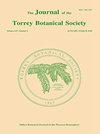Ground layer competition and herbivory effects on cherrybark oak (Quercus pagoda Raf.) regeneration in experimental canopy gaps1
IF 0.8
4区 生物学
Q4 PLANT SCIENCES
引用次数: 12
Abstract
COLLINS, BEVERLY (Savannah River Ecology Laboratory, Aiken, SC 29802). Ground layer competition and herbivory effects on cherrybark oak (Quercus pagoda Raf.) regeneration in experimental canopy gaps. J. Torrey Bot. Soc. 130:147-157. 2003. -Windthrows and small-scale forest harvests generate environmental heterogeneity and dense regrowth. In such sites, interactions among environmental factors, competition with ground layer vegetation, and herbivores attracted to the disturbed area all potentially influence recruitment and early establishment of canopy tree species. I examined the interactive effects of overstory gap size, canopy openness, herb layer competition, and mammalian (deer, swamp rabbits) herbivory on emergence and seedling bank formation of cherrybark oak, Quercus pagoda Raf., in experimental gaps created by mechanized logging in a bottomland hardwood forest. Acorns were planted in exclosures (deer, swamp rabbits, deer + swamp rabbits, neither) in the center of three gaps of each of six gap sizes (7, 10, 14, 20, 29, 40 m radius) and outside the exclosures in center, edge, and forest positions. Mortality was greatest during recruitment (within the first season), and was due primarily to damage to acorns by seed predators and shade effects on seedling establishment. After three seasons, seedlings from damaged acorns in the exclosure plots were shorter than those from undamaged acorns; however, these seedlings had higher relative growth rate, which suggests that acorn damage effects decline over time. Herb layer competition and shade due to position within a gap or gap size were associated with reduced survival or height of seedlings, both in the exclosures and in center, edge, and forest positions. Deer or rabbit herbivory had no measurable effect on seedling survival or growth over the first three seasons. Natural or created canopy gaps ' 14 m radius can be foci for Q. pagoda regeneration if acorns are protected from predators; however, the dense vegetation in regenerating gaps could limit seedling height growth and multiple openings may be necessary for ascent out of the seedling bank.试验林冠间隙中樱桃栎更新的地面层竞争和草食效应[j]
(萨凡纳河生态实验室,艾肯,南卡罗来纳州29802)试验林隙中樱桃栎更新过程中的地面层竞争和草食效应。托里·博特。Soc。130:147 - 157。2003. -风力和小规模森林采伐造成了环境异质性和密集的再生。在这些地点,环境因素之间的相互作用、与地面植被的竞争以及被干扰区域吸引的食草动物都可能影响冠层树种的补充和早期建立。研究了林隙大小、冠层开度、草本层竞争和哺乳动物(鹿、沼泽兔)食草性对樱桃栎出苗和幼苗库形成的交互作用。在一个低地阔叶林中,机械化采伐造成了实验缺口。在围篱(7、10、14、20、29、40 m半径)和围篱外的中心、边缘和林位分别种植橡子(鹿、沼泽兔、鹿+沼泽兔,两者均不种植)。采穗期间(第一季)死亡率最高,主要是由于种子捕食者对橡实的破坏和遮荫对幼苗形成的影响。3个季节后,围封地块受损橡实的幼苗比未受损橡实的幼苗短;然而,这些幼苗具有较高的相对生长率,这表明橡子损害效应随着时间的推移而减弱。草本层间的竞争和林隙内位置或林隙大小造成的遮荫与幼苗成活率或幼苗高度的降低有关,无论是在封地还是在中心、边缘和林位。鹿或兔的草食在前三个季节对幼苗的存活和生长没有可测量的影响。在保护橡子不受捕食者侵害的情况下,14 m半径的自然或人工树冠间隙可以成为刺柏再生的焦点;然而,再生林隙中茂密的植被可能会限制幼苗的高度生长,并且可能需要多个开口才能爬出幼苗库。
本文章由计算机程序翻译,如有差异,请以英文原文为准。
求助全文
约1分钟内获得全文
求助全文
来源期刊
CiteScore
0.70
自引率
0.00%
发文量
16
审稿时长
>12 weeks
期刊介绍:
The Journal of the Torrey Botanical Society (until 1997 the Bulletin of the Torrey Botanical Club), the oldest botanical journal in the Americas, has as its primary goal the dissemination of scientific knowledge about plants (including thallopyhtes and fungi). It publishes basic research in all areas of plant biology, except horticulture, with an emphasis on research done in, and about plants of, the Western Hemisphere.

 求助内容:
求助内容: 应助结果提醒方式:
应助结果提醒方式:


